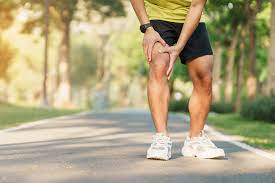Can you go for a satisfying run without experiencing post-workout pain when you tie your running shoes? Whether you engage in running for fitness purposes or to enhance your athletic performance, it is crucial to take preventative measures to ensure your body remains safe from long-term injuries.
Running is a highly favored method to maintain fitness as it requires minimal equipment and solely relies on one’s determination and proper footwear.

Most runners encounter injuries during their training at some stage. If you engage in regular running, it is advisable to take preventive measures to protect yourself from common injuries.
What are the Most Common Running Injuries?
Running has a cumulative effect on your joints, bones, muscles, and tendons, leading to various potential injuries. One of the most prevalent overuse injuries among runners is known as the runner’s knee, which ranks highest among them.
Below, you will find a compilation of additional frequent running injuries that you may encounter:
- Runner’s knee: The occurrence of pain when the kneecap and thigh bone do not properly align during joint movement.
- Shin splint: Pain in the front part of the lower legs, which is more commonly experienced when running on hard surfaces.
- Hamstring Injury: Pain in the back of the upper leg, with distance runners being more susceptible to strains and sprinters at risk for tears.
- Achilles tendinitis: Characterized by inflammation of the tendon connecting the heel and calf muscle, often exacerbated by increasing training intensity or mileage.
- IT band syndrome: When the IT band rubs against the leg bone, it can lead to pain in the outer area of the leg, particularly when the knee is bent.
- Repetitive impact: Causes hairline cracks in the bone, resulting in stress fractures. Runners often experience stress fractures in the heel, lower leg, or top of the foot.
- Plantar fasciitis: Degeneration of the tissue that protects the bottom of the foot can cause pain in the midfoot or heel.
- Ankle sprain: Overstretching of the ligaments between the ankle and leg, often occurring when landing on the foot incorrectly and rolling the ankle.
- Bursitis: Occurs when fluid-filled sacs beneath tendons and muscles become irritated due to repeated friction on the joint, causing inflammation.
- Meniscal tear: In some cases, the cartilage in the knee tears, leading to a sensation of the joint locking.
- Ingrown toenails: Improper shoe fit, where the edge of the nail grows into the skin, causing inflammation and pain.
These various running injuries can result in a variety of pain levels, ranging from slight discomfort to severe problems that interfere with your everyday tasks. If you suspect you have incurred a running injury, it is crucial to consult an orthopedic specialist.
Addressing the Root Issues: Poor Running Technique
What kind of injuries can arise due to inadequate running form? The fact is that a number of the ailments mentioned earlier can be avoided if you focus on improving your running technique.
How your body moves while running has an impact on your joints and tissues. If you persist with using the incorrect form despite experiencing pain, it will amplify the damage to your body.
Running away from pain is not effective. Instead, it is important to find ways to alleviate the stress and enable your body to function optimally.
How Do You Treat Running Injuries?
To prevent the running injury from worsening, it is important to seek immediate treatment and be proactive in preventing future injuries. Our team of orthopedic and sports medicine specialists suggests the following tips:
- Select appropriate footwear: Running shoes should be chosen for their functionality rather than style. It is important to choose shoes that provide proper support to your feet and offer a stable base while running. It is generally recommended to replace running shoes after covering a distance of 400 to 600 miles.
- Incorporate stretching: Regularly engage in stretching exercises to keep your muscles flexible and relaxed. Before starting your run, gently stretch and warm up. Additionally, dedicate 5 minutes at the end of your run for stretching.
- Include strength training exercises: Avoid relying solely on running as your exercise routine. Weak muscles can contribute to the running-related injuries mentioned earlier. Strengthening your muscles can help prevent such injuries.
- Pay attention to your body’s signals: When experiencing pain or discomfort, your body is signaling that something is amiss. As you understand your body better than anyone else, it would be wise to take a day off from training.
- Consult a sports medicine professional: If you aim to alleviate pain or improve your performance, consider seeking advice from a sports medicine doctor. Our team can provide personalized recommendations for injury prevention and recommend treatments to expedite your recovery.
- Set achievable goals: It is not advisable to transition from a sedentary lifestyle to running a 5k within a week. If you are starting a new routine or increasing your running regimen, take it gradually. Gradually increase the intensity and duration of your runs to allow your body to adapt and grow.
Schedule a Consultation with a Sports Medicine Doctor
You have the right to experience a sense of well-being and derive pleasure from your exercise sessions simultaneously. If you wish to enhance your running form and avoid getting injured, it can be beneficial to consult a specialist in sports medicine. Contact our team to arrange a consultation.
We provide customized solutions tailored to individuals of every age group. Regardless of whether you engage in occasional physical activities or not, our orthopedic physicians are capable of assisting. Our expertise extends to aiding in the process of injury recovery and rehabilitation. Moreover, these services can effectively enhance your overall performance.
please don’t hesitate to contact by
whatsapp or
email below
